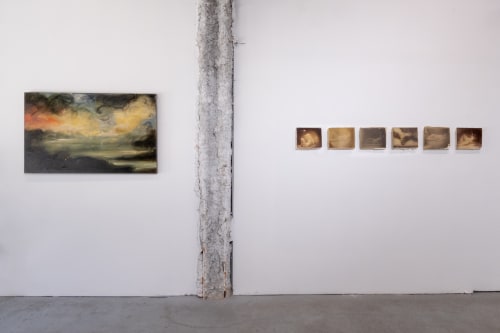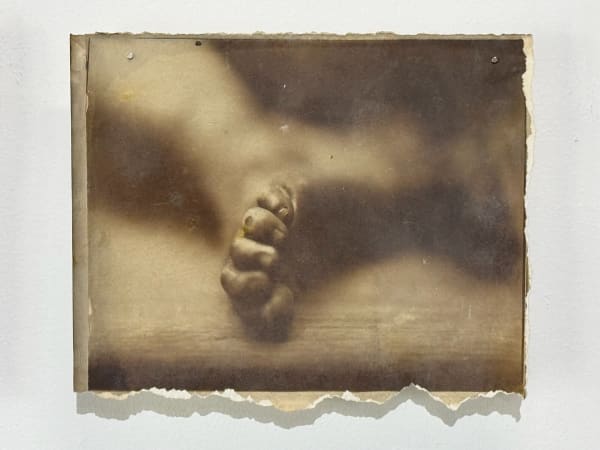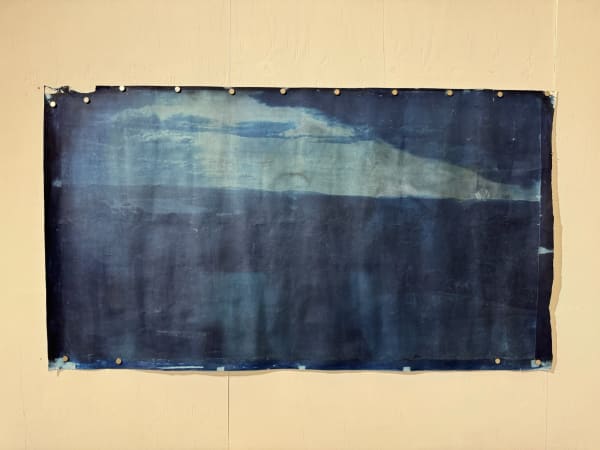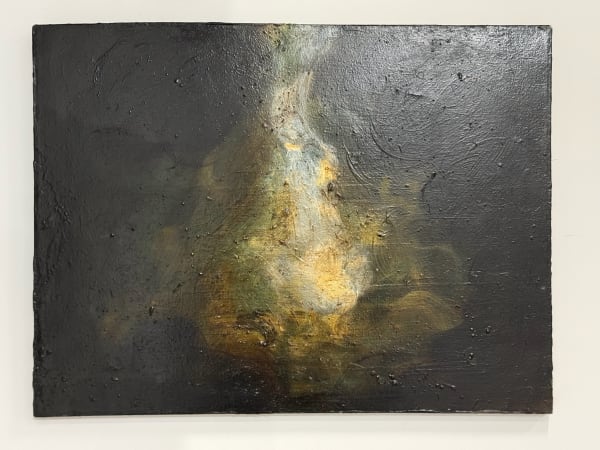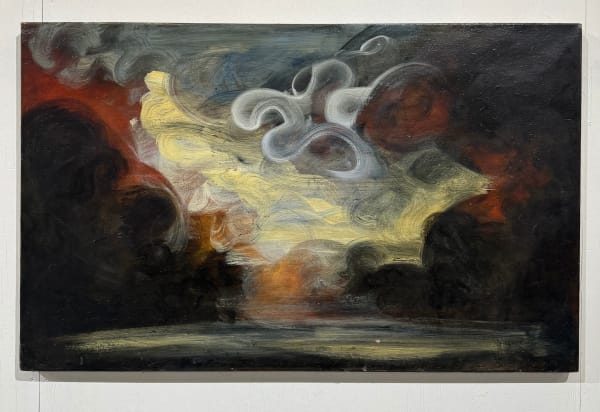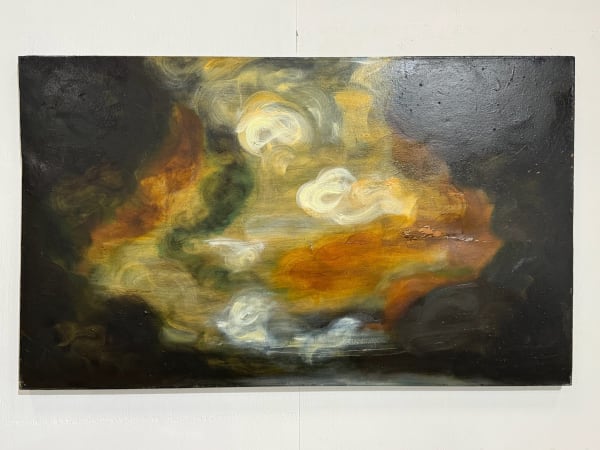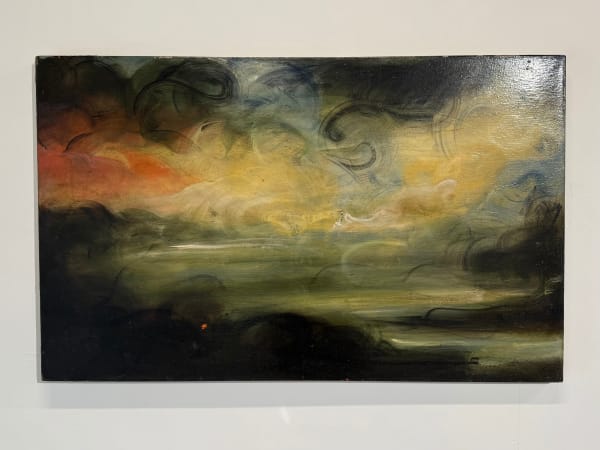HAL HIRSHORN (1965 – 2025)
MEMORIAL EXHIBITION
225 West 17th Street | March 27–29, 2025
251 West 19th Street | April 9 – May 10, 2025
The family of Hal Hirshorn (1965 – 2025) and Ethan Cohen Gallery would like to cordially invite you to Hal Hirshorn: Surrender Everything to the Sun, the largest and most comprehensive exhibition of Hirshorn’s extensive oeuvre, which includes paintings, abstract washes on paper, and photography. Hirshorn’s penchant for the poetic and the elusive led to a photographic practice in which he made landscapes and portraits with 19th century lenses and photographic processes, most frequently in the form of salt prints. Hirshorn would coat his own paper and print outdoors by exposing them to the sun, ergo the title of the exhibition, which derives from a statement Hirshorn made when describing his process, he was required to “Surrender Everything to the Sun”.
Following the memorial exhibition at 225 West 17th Street, Ethan Cohen Gallery will exhibit Hal Hirshorn’s works at its 251 West 19th Street space from April 9 – May 10, 2025.
Surrender Everything to the Sun
By Isaac Aden
Hal Hirshorn (American, 1965 – 2025) was an American artist who “made 21st century photography using 19th century materials and methods”. Hirshorn's extensive oeuvre includes paintings, abstract washes on paper, and photography. Hirshorn’s penchant for the poetic and the elusive led to a photographic practice in which he made landscapes and portraits with 19th century lenses and photographic processes, most frequently in the form of salt prints. Hirshorn would coat his own paper and print outdoors by exposing them to the sun which caused Hirshorn to say his process required him to, “Surrender Everything to the Sun”.
It seems like a lifetime ago when I first met Hal, he came into my life like the reprieve of a late summer's breeze. A lot was changing in my life at that time, and Hal compassionately offered his support to me, as I have come to know he selflessly did for so many others. His steadying words of wisdom in the face of what seemed to be insurmountable opposition, injustice, or personal turmoil helped guide me to an inner peace and serenity through understanding the distinction between actionable decisions and acceptance. Things in my life were simpler than before, and before the widespread connectivity of smartphones, I frequently would see him at openings, talks or performances. He always seemed to know where to go and when to leave. My sporadic encounters with him would often lead to long conversations on the stoop of his West Village apartment which carried long into the summer night. These talks were the basis for a deep and profound friendship.
Hal was not tall of stature; his hair was curly, and he wore a grizzled beard. His gaze was calm yet piercing. His hands revealed the manual aspect of his life’s commitment and always seemed coarse or cracked from the (al)chemical processes his work demanded. His dress was without exception distinguished however worn in just the way you’d expect of a true artist. His posture was frequently marked by a slight contrapposto as if life was breathed into a classical marble causing it to glide off its plinth. This made him effortlessly distinguishable in a crowd without the call for attention. Perhaps it was his direction of models which made him aware of the potential subtle positioning and posture can have over one’s presence.
He was a calm and gentle man; there was an undaunting deliberateness about him. He was very generous with his knowledge and his empathy. I witnessed this on countless occasions, not only directed at myself personally, but also at the benefit of complete strangers. He was one of the kindest souls I have ever come to know.
Trained as a painter at Bennington, Hirshorn created elusive, ethereal, and romantic paintings which seemed to slide out of the subconscious or a dream onto the canvas. Hirshorn’s hypnagogic paintings oscillate back and forth between naturalistic landscape and abstraction. Informed by formal compositional frameworks of Nicolas Poussin and Claude Lorrain. Hirshorn was keenly aware of the throughline which carried the development of western painting from discrete landscapes tucked behind portraits of Italian nobles, to the scale shift which saw the figure eclipsed by the landscape into the foreground only to be eventually abandoned entirely. Proceeding progressions would see the landscape scrubbed into abstraction, color field and eventually even minimalism. The fundamental issue at the heart of Hirshorn’s work was the relationship between painting and photography and how developments in each reverberated back and forth between the two, creating new spaces for artists to inhabit and create.
The early modern period of western painting idealized naturalistic representation and perspective. The desire to understand and therefore accurately depict the natural world led to the rise of empiricism. With the advent of the daguerreotype and the advancements in photography empirical representation would slowly shift away from painting. This is because it seemed the scientific reproduction offered by photography was more accurate and thus more desirable than the interpretive offers of a painter.
However, Hirshorn aptly pointed out to me that it was not so much photography exclusively, but printmaking that would cement this movement in painting away from representation and thereby open the door for the experimental approaches which would lead to the 20th century avant-garde. The impact of printmaking on painting can be seen in the proliferation of engraving. In the initial era of industrialization engraving was the predominant means of presenting images in widely circulated commercial magazines or newspapers. Engraving was an extension of drawing and therefore most frequently a tool honed by painters. The introduction and widespread commercial application of lithography would change this. The monumental broadsheets in the Paris subways and mass-produced images in the press shifted towards lithography and eventually photo lithography, thereby essentially overtaking the need for painters’ ability to realistically depict. The result was a movement away from empiricism toward romanticism as seen in the traditions of the Barbizon painters, the Tonalists, and the American Photo-Secessionists. It is in this liminal space where Hirshorn’s artistic practice is located.
Hirshorn's paintings were most frequently made from a palette favoring raw sienna. Hirshorn’s rendered atmospheric occurrences remind us that the clouds are made of water by rendering them so ineffably that at times they would seem to be a rushing torrent if they were not grounded by the slight inclinations of a horizon. Yet these indications do not fully ground them, and they are lifted to some otherworldly plain as Hirshorn clearly flirts with abstraction.
Aligned with these efforts Hirshorn amassed a separate and distinct body of discreet gestural abstract washes on paper which are clearly informed by and inform his paintings. Rendered in a deep Prussian blue which evokes the palette of a cyanotype, these quickly produced works allowed Hirshorn more instantaneous evidence of his efforts as opposed to the slow pace set by and patience perseverance of his printing practice. For Hirshorn the washes elicited a Zen like experience and awakened the poetic.
Furthermore, the washes tie his painting practice to his photography not only in their color but through the relationship between their paper substrates. Hirshorn would tear both the perimeters of the washes and his photographs by hand. This was the beginning of his printing process for both cyanotypes and salt prints. I recall he would wake up before dawn in the summer to prepare his prints for exposure to the sun. Rather than in the dark room, his printing process was done wholly outdoors. This facet of his practice required him to be keenly attuned to nature, always aware of the onset of clouds, the possibility of rain and to be especially aligned with the sun.
For those not fortunate enough to see the works in person, something must really be said about the quality of his prints and their surfaces. They are at once elegantly in accord with their subjects, smooth like skin, yet course around the edges like hands and feet which bear evidence of exhausting and ever incessant toil.
Hirshorn was particularly successful with his portraits. Perhaps this was because his gentle demeanor allowed him to create such a profound trust with his models. His portraits exude such sensitivity they stir the still moments which may be otherwise inconsequential and yet they comprise to the most profound recollections retained by one’s memory, such as the feeling of your skin during an unexpected summer’s rain, the melancholic ease of a Sunday with no regards, and the forlorn feeling of being single and longing while contemplating sea that is an unknown romantic frontier.
While his portraits are clearly informed by the tradition of the reclining nude, such as the Odalisque, they are distinct in that Hirshorn had a sacrosanct relationship with his models. This allowed for an intimacy between the models and Hirshorn outside of the male gaze, in which together they are able to establish a deep connection with the viewer which resonates within the very heart of the human condition. The unique way in which Hirshorn achieved this was through posture. Frequently the gaze of his models was averted, or their faces were obscured, such that conventional emotional reads of affect are traceless. His portraits reveal the deepest facets of human emotion primarily through the posture of the body.
Furthermore, Hirshorn also made prints in which he would include two images of the same model with one image being ever so slightly different from the other. This coupling evokes Eadweard Muybridge and at once imbues the work with a time-based aspect.
As with his paintings Hirshorn made use of the landscape as a subject for his photography. These works would often have blurred elements because with the long exposure of his cameras required, any wind which would carry a slight movement through a branch or roll clouds across a sky would further contribute to the ethereal quality of his work.
One of the distinguishing qualities of Hirshorn’s practice is the depth of field present in his work. He was fascinated by 19th century lenses and was such an avid collector of them to the point that whenever I went to his studio, they were stacked so high that they were almost about to tumble over in a calamitous cacophony. He would cobble together different lenses and camera bodies creating all manner of Frankenstein cameras. Frequently these would even employ digital backs. While Hirshorn was using 19th century processes it is important to note he was not a luddite. He was always the first person I knew to be up on the newest developments apps or editing software.
Some of his best conceptual landscape is the work he undertook at Philip Johnson's Glass House The seminal minimalist architectural achievement centers around a design in which the outer cladding of the house is made entirely of glass. The contours of the house frames the landscape creating a symbiotic relationship between the two. In a stroke of genius Hirshorn devised to use the planes of the Glass House as the viewfinder of his camera and created a brilliant body of work with this approach, with a number of prints being executed on a monumental scale.
Hirshorn also went to great lengths to stage complex tableaus in the tradition of memento mori photography. The tradition originated in the 19yh century in which families would take a portrait of a loved one who had passed away as a reminder or perhaps even because no other photograph had ever been taken. Hirshorn made use of funerary photography on several occasions even inserting apparitional abnormalities which alluded to 19th century spirit photography. Spirit photography was Hirshorn’s last endeavor; his final shoot was undertaken in a black cemetery in Georgia in which he recreated a slave funeral.
I often wondered to myself about the relevance of Hal’s work. I think I was intuitively drawn to it because I too was a deep lover of history. History and knowledge were an important part of Hirshorn’s practice. It seemed to me many contemporary artists had completely abandoned much of the vast knowledge of human history, becoming preoccupied with the modernist notion of originality for which the past was rendered irreverent. The obvious pitfall of this is one’s practice succumbing to the swing of the Hegelian pendulum just as the drop of a metaphorical aesthetic guillotine of disregard proffered by the next swing, only to render the practice obsolete and out of fashion. Furthermore, the same may be said for the subject, modernist preference for originality has led to the wholesale disregard of the comprehensive understanding of problems and conclusion previous centuries of artists have spent millenniums cumulatively addressing.
In the early 2000s, when I first met Hal, there was a crisis in photography. Advancements in mechanical reproduction had been dwarfed by the introduction of digital photography. At the time the primary back and forth was between the gearheads and the traditionalist. There was a movement towards digital photography, which was marked by those who most frequently championed a sort of empirical augment which aimed to pit the qualitative capacity of digital capturing or printing at odds with its analog counterpart. In reality it was the simultaneous development of the smartphone paired with an ever reliance on digital modes of communication which were the death knell for analog photography. No longer the argument over quality held water because all forms of visual communication were eventually brought to heel by the reliance or embrace of digital communication. Therefore, eventually all analog images needed to undergo digitization to remain relevant modes of visual communication. This flatlined analog processes in favor of digital ones because they streamlined the process. In the end the argument of quality was swallowed up by the speed required of a capitalist society. This brings us to Hirshorn’s work and the fundamental question of, what then is the value of using a form which has seemingly been made obsolete?
The answer is simpler than one might think. Fundamentally the same quandary is true for painting and yet, we still paint. So much of our society is shaped around capitalism and is based on speed and its relationship between production and consumption. The real answer depends on what you are asking, speed is not always the answer because those capitalist approaches don’t frequently consider quality first. Sometimes a slower means may yield better results. Many artists intuitively know this, Hal certainly did. That’s why he would slow his pace to the moment of a shadow, spending the whole day on a single print and surrender everything to the sun.
-
 Hal HirshornUntitled, c. 2000–2025Salt printApprox. 20.3 x 25.4 cm
Hal HirshornUntitled, c. 2000–2025Salt printApprox. 20.3 x 25.4 cm
Approx. 8 x 10 in -
 Hal HirshornUntitled, c. 2000–2025Salt printApprox. 20.3 x 25.4 cm
Hal HirshornUntitled, c. 2000–2025Salt printApprox. 20.3 x 25.4 cm
Approx. 8 x 10 in -
 Hal HirshornUntitled, c. 2000–2025Salt printApprox. 20.3 x 25.4 cm
Hal HirshornUntitled, c. 2000–2025Salt printApprox. 20.3 x 25.4 cm
Approx. 8 x 10 in -
 Hal HirshornUntitled, c. 2000–2025Salt printApprox. 20.3 x 25.4 cm
Hal HirshornUntitled, c. 2000–2025Salt printApprox. 20.3 x 25.4 cm
Approx. 8 x 10 in -
 Hal HirshornUntitled, c. 2000–2025Salt printApprox. 20.3 x 25.4 cm
Hal HirshornUntitled, c. 2000–2025Salt printApprox. 20.3 x 25.4 cm
Approx. 8 x 10 in -
 Hal HirshornUntitled, c. 2000–2025Salt printApprox. 20.3 x 25.4 cm
Hal HirshornUntitled, c. 2000–2025Salt printApprox. 20.3 x 25.4 cm
Approx. 8 x 10 in -
 Hal HirshornUntitled, c. 2000–2025Salt printApprox. 25.4 x 20.3 cm
Hal HirshornUntitled, c. 2000–2025Salt printApprox. 25.4 x 20.3 cm
Approx. 10 x 8 in -
 Hal HirshornUntitled, c. 2000–2025Salt printApprox. 25.4 x 20.3 cm
Hal HirshornUntitled, c. 2000–2025Salt printApprox. 25.4 x 20.3 cm
Approx. 10 x 8 in -
 Hal HirshornUntitled, c. 2000–2025Salt printApprox. 25.4 x 20.3 cm
Hal HirshornUntitled, c. 2000–2025Salt printApprox. 25.4 x 20.3 cm
Approx. 10 x 8 in -
 Hal HirshornUntitled, c. 2000–2025Salt printApprox. 25.4 x 20.3 cm
Hal HirshornUntitled, c. 2000–2025Salt printApprox. 25.4 x 20.3 cm
Approx. 10 x 8 in -
 Hal HirshornUntitled, c. 2000–2025Salt printApprox. 25.4 x 20.3 cm
Hal HirshornUntitled, c. 2000–2025Salt printApprox. 25.4 x 20.3 cm
Approx. 10 x 8 in -
 Hal HirshornUntitled, c. 2000–2025Salt printApprox. 25.4 x 20.3 cm
Hal HirshornUntitled, c. 2000–2025Salt printApprox. 25.4 x 20.3 cm
Approx. 10 x 8 in -
 Hal HirshornUntitled, c. 2000–2025Salt printApprox. 25.4 x 20.3 cm
Hal HirshornUntitled, c. 2000–2025Salt printApprox. 25.4 x 20.3 cm
Approx. 10 x 8 in -
 Hal HirshornUntitled, c. 2000–2025Salt printApprox. 25.4 x 20.3 cm
Hal HirshornUntitled, c. 2000–2025Salt printApprox. 25.4 x 20.3 cm
Approx. 10 x 8 in -
 Hal HirshornUntitled, c. 2000–2025Salt printApprox. 25.4 x 20.3 cm
Hal HirshornUntitled, c. 2000–2025Salt printApprox. 25.4 x 20.3 cm
Approx. 10 x 8 in -
 Hal HirshornUntitled, c. 2000–2025Salt printApprox. 25.4 x 20.3 cm
Hal HirshornUntitled, c. 2000–2025Salt printApprox. 25.4 x 20.3 cm
Approx. 10 x 8 in -
 Hal HirshornUntitled, c. 2000–2025Salt printApprox. 25.4 x 20.3 cm
Hal HirshornUntitled, c. 2000–2025Salt printApprox. 25.4 x 20.3 cm
Approx. 10 x 8 in -
 Hal HirshornUntitled, c. 2000–2025Salt printApprox. 25.4 x 20.3 cm
Hal HirshornUntitled, c. 2000–2025Salt printApprox. 25.4 x 20.3 cm
Approx. 10 x 8 in -
 Hal HirshornUntitled, c. 2000–2025Salt printApprox. 25.4 x 20.3 cm
Hal HirshornUntitled, c. 2000–2025Salt printApprox. 25.4 x 20.3 cm
Approx. 10 x 8 in -
 Hal HirshornUntitled, c. 2000–2025Salt printApprox. 25.4 x 20.3 cm
Hal HirshornUntitled, c. 2000–2025Salt printApprox. 25.4 x 20.3 cm
Approx. 10 x 8 in -
 Hal HirshornUntitled, c. 2000–2025Salt printApprox. 25.4 x 20.3 cm
Hal HirshornUntitled, c. 2000–2025Salt printApprox. 25.4 x 20.3 cm
Approx. 10 x 8 in -
 Hal HirshornUntitled, c. 2000–2025Salt printApprox. 25.4 x 20.3 cm
Hal HirshornUntitled, c. 2000–2025Salt printApprox. 25.4 x 20.3 cm
Approx. 10 x 8 in -
 Hal HirshornUntitled, c. 2000–2025Salt printApprox. 25.4 x 20.3 cm
Hal HirshornUntitled, c. 2000–2025Salt printApprox. 25.4 x 20.3 cm
Approx. 10 x 8 in -
 Hal HirshornUntitled, c. 2000–2025Salt printApprox. 25.4 x 20.3 cm
Hal HirshornUntitled, c. 2000–2025Salt printApprox. 25.4 x 20.3 cm
Approx. 10 x 8 in -
 Hal HirshornUntitled, c. 2000–2025Salt printApprox. 25.4 x 20.3 cm
Hal HirshornUntitled, c. 2000–2025Salt printApprox. 25.4 x 20.3 cm
Approx. 10 x 8 in -
 Hal HirshornUntitled, c. 2000–2025Salt printApprox. 25.4 x 20.3 cm
Hal HirshornUntitled, c. 2000–2025Salt printApprox. 25.4 x 20.3 cm
Approx. 10 x 8 in -
 Hal HirshornUntitled, c. 2000–2025Salt printApprox. 25.4 x 20.3 cm
Hal HirshornUntitled, c. 2000–2025Salt printApprox. 25.4 x 20.3 cm
Approx. 10 x 8 in -
 Hal HirshornUntitled, c. 2000–2025Salt printApprox. 25.4 x 20.3 cm
Hal HirshornUntitled, c. 2000–2025Salt printApprox. 25.4 x 20.3 cm
Approx. 10 x 8 in -
 Hal HirshornUntitled, c. 2000–2025Salt printApprox. 25.4 x 20.3 cm
Hal HirshornUntitled, c. 2000–2025Salt printApprox. 25.4 x 20.3 cm
Approx. 10 x 8 in -
 Hal HirshornUntitled, c. 2000–2025Salt printApprox. 25.4 x 20.3 cm
Hal HirshornUntitled, c. 2000–2025Salt printApprox. 25.4 x 20.3 cm
Approx. 10 x 8 in -
 Hal HirshornUntitled, c. 2000–2025Salt printApprox. 25.4 x 20.3 cm
Hal HirshornUntitled, c. 2000–2025Salt printApprox. 25.4 x 20.3 cm
Approx. 10 x 8 in -
 Hal HirshornUntitled, c. 2000–2025Salt printApprox. 25.4 x 20.3 cm
Hal HirshornUntitled, c. 2000–2025Salt printApprox. 25.4 x 20.3 cm
Approx. 10 x 8 in -
 Hal HirshornUntitled, c. 2000–2025Salt printApprox. 25.4 x 20.3 cm
Hal HirshornUntitled, c. 2000–2025Salt printApprox. 25.4 x 20.3 cm
Approx. 10 x 8 in -
 Hal HirshornUntitled, c. 2000–2025Salt printApprox. 25.4 x 20.3 cm
Hal HirshornUntitled, c. 2000–2025Salt printApprox. 25.4 x 20.3 cm
Approx. 10 x 8 in -
 Hal HirshornUntitled, c. 2000–2025Salt printApprox. 25.4 x 20.3 cm
Hal HirshornUntitled, c. 2000–2025Salt printApprox. 25.4 x 20.3 cm
Approx. 10 x 8 in -
 Hal HirshornUntitled, c. 2000–2025Salt printApprox. 25.4 x 20.3 cm
Hal HirshornUntitled, c. 2000–2025Salt printApprox. 25.4 x 20.3 cm
Approx. 10 x 8 in -
 Hal HirshornUntitled, c. 2000–2025Salt printApprox. 25.4 x 20.3 cm
Hal HirshornUntitled, c. 2000–2025Salt printApprox. 25.4 x 20.3 cm
Approx. 10 x 8 in -
 Hal HirshornUntitled, c. 2000–2025Salt printApprox. 25.4 x 20.3 cm
Hal HirshornUntitled, c. 2000–2025Salt printApprox. 25.4 x 20.3 cm
Approx. 10 x 8 in -
 Hal HirshornUntitled, c. 2000–2025Salt printApprox. 25.4 x 20.3 cm
Hal HirshornUntitled, c. 2000–2025Salt printApprox. 25.4 x 20.3 cm
Approx. 10 x 8 in -
 Hal HirshornUntitled, c. 2000–2025Salt printApprox. 25.4 x 20.3 cm
Hal HirshornUntitled, c. 2000–2025Salt printApprox. 25.4 x 20.3 cm
Approx. 10 x 8 in -
 Hal HirshornUntitled, c. 2000–2025Salt printApprox. 20.3 x 25.4 cm
Hal HirshornUntitled, c. 2000–2025Salt printApprox. 20.3 x 25.4 cm
Approx. 8 x 10 in -
 Hal HirshornUntitled, c. 2000–2025Salt printApprox. 20.3 x 25.4 cm
Hal HirshornUntitled, c. 2000–2025Salt printApprox. 20.3 x 25.4 cm
Approx. 8 x 10 in -
 Hal HirshornUntitled, c. 2000–2025Salt printApprox. 20.3 x 25.4 cm
Hal HirshornUntitled, c. 2000–2025Salt printApprox. 20.3 x 25.4 cm
Approx. 8 x 10 in -
 Hal HirshornUntitled, c. 2000–2025Salt printApprox. 20.3 x 25.4 cm
Hal HirshornUntitled, c. 2000–2025Salt printApprox. 20.3 x 25.4 cm
Approx. 8 x 10 in -
 Hal HirshornUntitled, c. 2000–2025Salt printApprox. 20.3 x 25.4 cm
Hal HirshornUntitled, c. 2000–2025Salt printApprox. 20.3 x 25.4 cm
Approx. 8 x 10 in -
 Hal HirshornUntitled, c. 2000–2025Salt printApprox. 20.3 x 25.4 cm
Hal HirshornUntitled, c. 2000–2025Salt printApprox. 20.3 x 25.4 cm
Approx. 8 x 10 in -
 Hal HirshornUntitled, c. 2000–2025Salt printApprox. 20.3 x 25.4 cm
Hal HirshornUntitled, c. 2000–2025Salt printApprox. 20.3 x 25.4 cm
Approx. 8 x 10 in -
 Hal HirshornUntitled, c. 2000–2025Salt printApprox. 25.4 x 20.3 cm
Hal HirshornUntitled, c. 2000–2025Salt printApprox. 25.4 x 20.3 cm
Approx. 10 x 8 in -
 Hal HirshornUntitled, c. 2000–2025Salt printApprox. 25.4 x 20.3 cm
Hal HirshornUntitled, c. 2000–2025Salt printApprox. 25.4 x 20.3 cm
Approx. 10 x 8 in -
 Hal HirshornUntitled, c. 2000–2025Salt printApprox. 25.4 x 20.3 cm
Hal HirshornUntitled, c. 2000–2025Salt printApprox. 25.4 x 20.3 cm
Approx. 10 x 8 in -
 Hal HirshornUntitled, c. 2000–2025Salt printApprox. 25.4 x 20.3 cm
Hal HirshornUntitled, c. 2000–2025Salt printApprox. 25.4 x 20.3 cm
Approx. 10 x 8 in -
 Hal HirshornUntitled, c. 2000–2025Salt printApprox. 25.4 x 20.3 cm
Hal HirshornUntitled, c. 2000–2025Salt printApprox. 25.4 x 20.3 cm
Approx. 10 x 8 in -
 Hal HirshornUntitled, c. 2000–2025Salt printApprox. 25.4 x 20.3 cm
Hal HirshornUntitled, c. 2000–2025Salt printApprox. 25.4 x 20.3 cm
Approx. 10 x 8 in -
 Hal HirshornUntitled, c. 2000–2025Salt printApprox. 25.4 x 20.3 cm
Hal HirshornUntitled, c. 2000–2025Salt printApprox. 25.4 x 20.3 cm
Approx. 10 x 8 in -
 Hal HirshornUntitled, c. 2000–2025Salt printApprox. 25.4 x 20.3 cm
Hal HirshornUntitled, c. 2000–2025Salt printApprox. 25.4 x 20.3 cm
Approx. 10 x 8 in -
 Hal HirshornUntitled, c. 2000–2025Salt printApprox. 25.4 x 20.3 cm
Hal HirshornUntitled, c. 2000–2025Salt printApprox. 25.4 x 20.3 cm
Approx. 10 x 8 in -
 Hal HirshornUntitled, c. 2000–2025Salt printApprox. 25.4 x 20.3 cm
Hal HirshornUntitled, c. 2000–2025Salt printApprox. 25.4 x 20.3 cm
Approx. 10 x 8 in -
 Hal HirshornUntitled, c. 2000–2025Salt printApprox. 25.4 x 20.3 cm
Hal HirshornUntitled, c. 2000–2025Salt printApprox. 25.4 x 20.3 cm
Approx. 10 x 8 in -
 Hal HirshornUntitled, c. 2000–2025Salt printApprox. 25.4 x 20.3 cm
Hal HirshornUntitled, c. 2000–2025Salt printApprox. 25.4 x 20.3 cm
Approx. 10 x 8 in -
 Hal HirshornUntitled, c. 2000–2025Salt printApprox. 25.4 x 20.3 cm
Hal HirshornUntitled, c. 2000–2025Salt printApprox. 25.4 x 20.3 cm
Approx. 10 x 8 in -
 Hal HirshornUntitled, c. 2000–2025Salt printApprox. 25.4 x 20.3 cm
Hal HirshornUntitled, c. 2000–2025Salt printApprox. 25.4 x 20.3 cm
Approx. 10 x 8 in -
 Hal HirshornUntitled, c. 2000–2025Salt printApprox. 25.4 x 20.3 cm
Hal HirshornUntitled, c. 2000–2025Salt printApprox. 25.4 x 20.3 cm
Approx. 10 x 8 in -
 Hal HirshornUntitled, c. 2000–2025Salt printApprox. 25.4 x 20.3 cm
Hal HirshornUntitled, c. 2000–2025Salt printApprox. 25.4 x 20.3 cm
Approx. 10 x 8 in -
 Hal HirshornUntitled, c. 2000–2025Salt printApprox. 25.4 x 20.3 cm
Hal HirshornUntitled, c. 2000–2025Salt printApprox. 25.4 x 20.3 cm
Approx. 10 x 8 in -
 Hal HirshornUntitled, c. 2000–2025Salt printApprox. 25.4 x 20.3 cm
Hal HirshornUntitled, c. 2000–2025Salt printApprox. 25.4 x 20.3 cm
Approx. 10 x 8 in -
 Hal HirshornUntitled, c. 2000–2025Salt printApprox. 25.4 x 20.3 cm
Hal HirshornUntitled, c. 2000–2025Salt printApprox. 25.4 x 20.3 cm
Approx. 10 x 8 in -
 Hal HirshornUntitled, c. 2000–2025Salt printApprox. 25.4 x 20.3 cm
Hal HirshornUntitled, c. 2000–2025Salt printApprox. 25.4 x 20.3 cm
Approx. 10 x 8 in -
 Hal HirshornUntitled, c. 2000–2025Salt printApprox. 25.4 x 20.3 cm
Hal HirshornUntitled, c. 2000–2025Salt printApprox. 25.4 x 20.3 cm
Approx. 10 x 8 in -
 Hal Hirshornc. 2000–2025Cyanotype on fabric
Hal Hirshornc. 2000–2025Cyanotype on fabric -
 Hal Hirshornc. 2000–2025Cyanotype on fabric
Hal Hirshornc. 2000–2025Cyanotype on fabric -
 Hal Hirshornc. 2000–2025Cyanotype on fabric
Hal Hirshornc. 2000–2025Cyanotype on fabric -
 Hal HirshornOvia in Exile, 2006Oil on canvas121.9 x 152.4 cm
Hal HirshornOvia in Exile, 2006Oil on canvas121.9 x 152.4 cm
48 x 60 in -
 Hal HirshornDelphi, 2000Oil on canvas45.7 x 61 cm
Hal HirshornDelphi, 2000Oil on canvas45.7 x 61 cm
18 x 24 in -
 Hal HirshornSwan Song, 2002Oil on canvas76.2 x 121.9 cm
Hal HirshornSwan Song, 2002Oil on canvas76.2 x 121.9 cm
30 x 48 in -
 Hal Hirshornc. 1990–2015Oil on canvas
Hal Hirshornc. 1990–2015Oil on canvas -
 Hal HirshornUntitled, 2006Oil on canvas
Hal HirshornUntitled, 2006Oil on canvas -
 Hal Hirshornc. 1990–2015Oil on canvas
Hal Hirshornc. 1990–2015Oil on canvas -
 Hal HirshornWatch Over the Rhine, 2006Oil on canvas121.9 x 152.4 cm
Hal HirshornWatch Over the Rhine, 2006Oil on canvas121.9 x 152.4 cm
48 x 60 in -
 Hal HirshornSiegfried and the Rhine, 2002Oil on canvas76.2 x 101.6 cm
Hal HirshornSiegfried and the Rhine, 2002Oil on canvas76.2 x 101.6 cm
30 x 40 in -
 Hal Hirshorn2006Oil on canvas
Hal Hirshorn2006Oil on canvas -
 Hal HirshornUntitled, c. 1990–2015Oil on canvas
Hal HirshornUntitled, c. 1990–2015Oil on canvas -
 Hal HirshornUntitled, 2006Oil on canvas
Hal HirshornUntitled, 2006Oil on canvas -
 Hal HirshornFlanders, 2005Oil on canvas76.2 x 121.9 cm
Hal HirshornFlanders, 2005Oil on canvas76.2 x 121.9 cm
30 x 48 in


